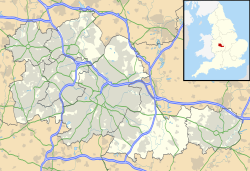St. Mary's College, Oscott
| Oscott College | |
|---|---|
| St Mary's College, New Oscott | |

View of the college from the south
|
|
| Coordinates: 52°32′38″N 1°51′20″W / 52.543766°N 1.855451°W | |
| OS grid reference | SP0988894038 |
| Location | New Oscott, Birmingham |
| Country | UK |
| Denomination | Roman Catholic |
| Website | oscott |
| History | |
| Founded | May 1794 |
| Founder(s) | Thomas Walsh |
| Dedication | St Mary |
| Consecrated | 29 May 1838 |
| Associated people |
Cardinal Wiseman |
| Architecture | |
| Status | Seminary |
| Functional status | Active |
| Heritage designation | Grade II* Listed |
| Designated | 25 April 1952 |
| Architect(s) | A.W. Pugin |
| Style | Gothic Revival |
| Groundbreaking | 25 April 1836 |
| Completed | 31 May 1838 |
| Construction cost | £40,000 |
| Administration | |
| Parish | Our Lady of the Assumption Maryvale |
| Deanery | Birmingham (North) |
| Archdiocese | Birmingham |
| Province | Birmingham |
| Clergy | |
| Archbishop | Bernard Longley |
| Rector | Canon David Oakley |
Cardinal Wiseman
Bernard Griffin
Cardinal Newman
St Mary's College in New Oscott, Birmingham, often called Oscott College, is the Roman Catholic seminary of the Archdiocese of Birmingham in England and one of the three seminaries of the Catholic Church in England and Wales;
Oscott College admits students for the priesthood from various dioceses of England and Wales, as well as some students from overseas. The first three years of the academic programme are validated by the University of Birmingham as a BA in Fundamental Catholic Theology. Those who complete the six-year programme also obtain an Bachelor of Sacred Theology (STB) through affiliation with the Katholieke Universiteit Leuven.
Oscott College is also the diocesan centre for the formation of candidates for the permanent diaconate within the Archdiocese of Birmingham.
The college was founded in Oscott, in present-day Great Barr, in 1794 for both the training of priests and the education of lay pupils. It developed out of a small mission founded by Fr Andrew Bromwich around 1687.
In 1838 the college moved to a new site, which came to be known as New Oscott (and the original site as "Old Oscott"). The Maryvale Institute remains on the original site. The new building was designed by Augustus Pugin and Joseph Potter at a cost of £40,000. It is grade II* listed. The college quickly became a symbol of the rebirth of the Catholic faith in England and played a prominent part in the life of the Church in the 19th century. In 1889, the college was closed, but reopened the following year as a seminary only.
...
Wikipedia

